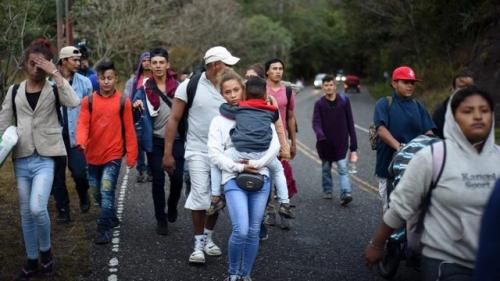Criminalization of the Honduran migrant caravan
- Opinión

“No one leaves home unless
home is the mouth of a shark
you only run for the border
when you see the whole city running as well”
Warsan Shire.
In the context of the Central and North American regions, the irregular migrations from the Northern Triangle of Central America with the main destination to the United States of America (USA), not only refer to processes of forced cross-border human mobility and strong changes and adjustments in the labor market and the productive structure (of the countries of origin and destination), also and especially allude to the hardening (securitization / militarization) of the borders and the increasing criminalization of the migrant in the origin, transit and destination [1]. Borders have become territories of exclusion (for precarious and undocumented workers), and devices of violence towards these precarious populations [2]. At the end of September and beginning of October a “caravan” of Honduran migrants left San Pedro Sula, it was made up of men, women, families, adolescents and children. According to Honduran media (such as Radio Progreso), the causes of this migrant caravan were the adverse situations that had already existed for years and have only been accentuated by the pandemic, and refer to chronic and structural poverty, lack of jobs, insufficient salaries, in addition to the well-known corruption and general violence of the family and of gangs and organized crime [3].
However, the caravans, far from being directed and provoked by the interests of groups outside the migrants (as has been echoed in various media), have been strategies and collective actions that, with a certain degree of improvisation / spontaneity and through various practices (walking in groups, spending the night together, holding recurring assemblies and generating temporary commissions), have tried to have safer migration paths [4]. The visibility of the “caravan” has been a form of protection against various social actors and institutions that attack them (organized crime, gangs, authorities, etc.) [5].
However, the response of various governments in the Central and North American region was to stop and dismantle this new caravan in the context of the COVID 19 pandemic, and under alleged arguments of a health emergency and irregular migratory conditions. However, to understand the processes of closure and securitization of borders in Central America, it is necessary to consider the great weight of the asymmetric intra-regional geopolitical context, where the United States prevails and imposes its racist migratory agenda and interests [6]. Particularly accentuated has been the US pressure of an economic nature (through the removal of aid plans, the imposition of sanctions and the threat of tariffs), so that the countries of the Central American region contain the migrant caravans at any cost [7].
Notes
[1] Castillo Ramírez, G. (2019). Flujos de movilidad mixtos. Relaciones entre migraciones forzadas, procesos espaciales y violencia. Procesos Migratorios en México, nuevos rostros, mismas dinámicas, Informe REDODEM 2018. http://redodem.org/wp-content/uploads/2019/09/REDODEM-Informe-2018.pdf
[2] Castillo Ramírez, G. (2020). Forced migration and violence process: Centroamerican migrants in their way through México. Revista Española de Educación Comparada, 35.http://revistas.uned.es/index.php/REEC/article/view/25163.
[3] Radio Progreso, Página Oficial https://www.facebook.com/178801698840423/videos/842141529860656
[4] Frank-Vitale, A., y Nuñez, M. (2020). “Lady Frijoles”: las caravanas centroamericanas y el poder de la hípervisibilidad de la migración indocumentada. EntreDiversidades, 1(14). http://entrediversidades.unach.mx/index.php/entrediversidades/article/view/158/347
[5] Frank-Vitale, A., y Nuñez, M. (2020).“Lady Frijoles”: las caravanas centroamericanas y el poder de la hípervisibilidad de la migración indocumentada. EntreDiversidades, 1(14). http://entrediversidades.unach.mx/index.php/entrediversidades/article/view/158/347
[6] Migraciones en México: fronteras, omisiones y transgresiones, Informe 2019 REDODEM. http://redodem.org/wp-content/uploads/2020/09/REDODEM_Informe_2019.pdf
[7] Migraciones en México: fronteras, omisiones y transgresiones, Informe REDODEM 2019. http://redodem.org/wp-content/uploads/2020/09/REDODEM_Informe_2019.pdf
Del mismo autor
- Forced internal displacement in Mexico and processes of violence 13/03/2022
- Labor struggles against precarious work and agribusiness exploitation 09/01/2022
- Detentions, deportations, and criminalization of migrants 29/11/2021
- México: detenciones, deportaciones y criminalización de los migrantes 15/11/2021
- Visibility of migrant voices and subjects 18/10/2021
- La decolonialidad y el abordaje de las movilidades humanas transfronterizas 01/10/2021
- Migrants, social organizations, and policies to control cross-border mobility 20/09/2021
- Decoloniality and sense of the production of social knowledge 06/09/2021
- Decolonialidad y sentido de la producción de conocimiento social 26/08/2021
- México: migrantes, organizaciones sociales y políticas del control de las movilidades transfronterizas 09/08/2021
